Elsenborn Ridge
| Elsenborn Ridge | |||||||
|---|---|---|---|---|---|---|---|
| Part of World War II, Battle of the Bulge | |||||||
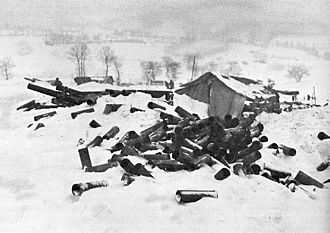 Discarded artillery shell casings litter a U.S. Artillery position on Elsenborn Ridge. | |||||||
| |||||||
| Belligerents | |||||||
|
|
| ||||||
| Commanders and leaders | |||||||
|
|
| ||||||
| Units involved | |||||||
|
1st Infantry Division 2nd Infantry Division 9th Infantry Division 99th Infantry Division |
12th SS Panzer Division 3rd Panzergrenadier Division 277th Volksgenadier Division 12th Volksgrenadier Division 246th Volksgrenadier Division | ||||||
| Strength | |||||||
| 28,000 men | 56,000 men | ||||||
| Casualties and losses | |||||||
| 5,000 men killed or missing |
114 tanks and vehicles, Unknown, but high personnel losses | ||||||
| ||||||
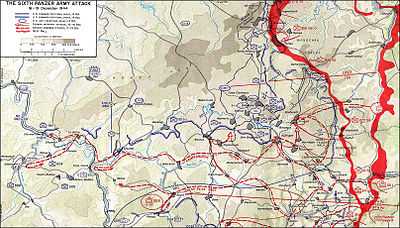
The Elsenborn Ridge is a ridge line east of the town of Elsenborn, Belgium in the Ardennes forest that was the blocking line on the northern shoulder of the Battle of the Bulge. Their area was the main line of advance for Hitler's prized 12th SS Panzer Division Hitlerjugend. However, units of V Corps of the First U.S. 1st Army held the ridge against the elite division, preventing it, and attached forces, from reaching the vast array of supplies near the cities of Liège and Spa, Belgium and the road network west of the Elsenborn Ridge leading to the Meuse River and Antwerp.[1] This was the only sector of the American front line during the Battle of the Bulge where the Germans failed to advance.[2]
In a fierce battle lasting 10 days, the American and German lines were often confused. During the first three days, the battle was for the twin villages of Rocherath-Krinkelt, during which American G.I.s were at times isolated in individual buildings surrounded by German armor. Attacking Elsenborn Ridge itself, the Germans, although superior in numbers, were stopped by the Americans' well-prepared and deeply dug-in defensive positions. The German attack plans were not well coordinated and frustrated by the rugged terrain, built-up areas around the twin villages, and massed American artillery firepower positioned behind Elsenborn ridge. U.S. artillery batteries repeatedly pounded the German advance. While the Germans employed an effective combined arms tactic and penetrated the U.S. lines several times, the Americans called in indirect fire on their own positions, pushing the Germans back. U.S. reserve forces consisting of clerks and headquarters personnel were rushed in at one point to reinforce the 395th Infantry Regiment's lines. Although the Germans possessed superior armor, they were held in check by the innovative American tactics including better communication, coordinated time on target artillery strikes, new proximity fuses for artillery shells, and superior air power.
The Sixth Panzer Army was unable to break through and advance to its immediate objectives on the Meuse River. The stubborn American resistance forced Kampfgruppe Peiper to choose an alternative route south of their original plan. As a result, the German forces were strung out over miles of winding, single-track roads, unable to concentrate their armored units. Peiper's units were repeatedly stymied by U.S. Army Engineers, who blew essential bridges along their route of advance. One column of roughly 40 tanks and support vehicles was destroyed on December 17 when they were discovered by an L4 air observer of the 62nd AFA Bn, assigned to the 102nd Cavalry Group. They were attacked by the 62nd's 105 howitzers mounted on M7 SP's, Corps 155's and Army 240's. [3] The Panzers finally reached the Ambleve River, only about halfway to the Meuse River, but could not advance when they ran out of fuel. Food and ammunition also ran low. After 10 days, the German forces had been reduced to an ineffective strength and withdrew. The Americans had about 5,000 casualties; while exact German losses are not known, they included significant amounts of armor. While the Americans had considerable supplies and enough troops to re-equip their forces, German losses couldn't be replaced.
Because of the success of the 395th and the 99th, the Americans maintained effective freedom to maneuver across the north flank of the German's line of advance and continually limited the success of the German offensive. The forces defending Elsenborn Ridge stopped the German's main axis of advance, but other actions during the Battle of the Bulge received much greater attention from the press. This was because during early December 1944, Bastogne was a rest and recreation area for many war correspondents. Their reports on the battle around Bastogne were published in newspaper articles and on radio. There were no correspondents in Saint-Vith, Elsenborn or Monschau.[4]
Key position in the Battle of the Bulge
The area around Höfen and Monschau was critical because of the road network that lay behind it. The Germans had planned a seven-day campaign to seize Antwerp, and they were counting on that road system to help them achieve that objective. The Battle of Elsenborn Ridge became a decisive component of the Battle of the Bulge when the U.S. Army was able to deflect the strongest armored units of the German advance.[5] Portions of both sides' forces had little battle experience, and both employed newer, more lethal weapons and tactics. This gave the battle a brutal intensity and impact, resulting in high casualties and traumatic memories and experiences for the participants.
German units
The units responsible for seizing the northern sector of the offensive were specially chosen by Adolf Hitler and given priority for supply and equipment. Sepp Dietrich’s Sixth Panzer Army was given the lead role in the overall battle. It was made up of the best-equipped elite SS armored divisions on the western front. The panzer divisions were led by the 1st SS Panzer Division, which had been formed from Adolf Hitler's personal bodyguard regiment. It had the primary responsibility for breaking through the Allied lines and reaching the Meuse River and Antwerp, Belgium. The 2nd SS Panzer Division was an elite Waffen-SS division amongst the thirty-eight Waffen-SS divisions, the 9th SS Panzer Division was an armored division formed of 18 year old German conscripts led by a cadre of experienced staff from the Leibstandarte SS Adolf Hitler. Major General Engel’s 12th SS Panzer Division, a German Waffen SS armoured division whose junior officers and enlisted men were drawn from members of the Hitler Youth, while the senior NCOs and officers were generally veterans of the Eastern Front.
The armoured units were supported by the 3rd Panzer Grenadier Division, the 3rd Fallschirmjaeger Division, and four Volksgrenadier (Infantry) divisions: the 277th; the 326th, which was designated to take the area north and south of Monschau, which Field Marshal Walter Model had directed should be spared destruction; and the 246th, which was tasked with taking Höfen and Monschau and nearby villages and then driving northwest to seize the Eupen road. The attack west was led by Kampfgruppe SS Standartenführer Joachim Peiper's 1st SS Panzer Division was designated to advance on rollbahn B, a route that would lead them through Spa, Belgium to Antwerp. The infantry would then secure the right flank of the attack route near Losheimergraben.
Allied positions
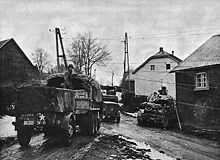
The terrain near Elsenborn Ridge was open and rolling. The initial role of the 395th was to support the 2nd Infantry Division in its attack in the Wahlerscheid sector on the Siegfried Line. The 1st and 3rd Battalions of the 395th Infantry Regiment and one from the 393rd formed the 395th Regimental Combat Team (RCT). They initiated an attack on December 13 against German positions about 1.5 miles (2.4 km) southeast of Wahlerscheid. The attack went well at first, and slowed considerably when German resistance stiffened on December 14.[6]
The American defenders had six weeks to prepare their defensive positions. They were well dug in and had wired their positions with trip flares and barbed wire. In early December, the front was unusually calm and the weather was bone-chilling cold. The 99th was firmly emplaced on a front stretching from Monschau, Germany to Losheimergraben, Belgium, on the south, totaling 35 kilometres (22 mi). With such a long front to watch over, Maj. Gen. Walter E. Lauer found it necessary to place all three regiments on line. The 395th was in the north, the 393rd Regiment in the center, and the 394th in the south. Each regiment was responsible for protecting approximately 11 kilometres (6.8 mi) of front, roughly equivalent to one front-line infantry man every 91 metres (299 ft). The 38th Cavalry Squadron outpost to the north, on the regimental left, lay within about 200 yards (180 m) from the German bunkers on the Siegfried Line, while the units on the right were more than 800 metres (2,600 ft) from the German lines.
The width of the front held by about 600 front-line infantry men of the 1st and 3rd Battalions was about 6,000 yards (5,500 m) long and they had no units in reserve.[7] There were many gaps in the line. Lt. Col. McClernand Butler, commanding officer of the 395th, later wrote:
| “ | That is three to four times wider than recommended by Army textbooks. I never dreamed that we would have a defensive position of this size without any backup or help from our division or regiment. When I got to Höfen, I found the area too big to cover in one afternoon. So I stayed in the village overnight."[8]:79 | ” |
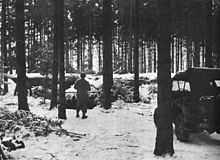
Butler held a single platoon of 40 men from Company L in reserve. In the event of an emergency, the battalion headquarters and company administrative personnel, including clerks and motor-pool staff, were to join the platoon, creating a small reserve force of about 100 men. If the Germans penetrated Höfen, the U.S. soldiers would have to withdraw several miles to the next defensible position.[9]
The infantry at Höfen lay in a foxhole line along a 910 metres (2,990 ft) front on the eastern side of the village, backed up by dug-in support positions. These would later prove instrumental in defending themselves from the attacking Germans and in protecting themselves when their own artillery fired on or just in front of their own positions, which happened at least six times over the next few weeks.

On December 14, the veteran soldiers of Company A, 612th Tank Destroyer Battalion, dispersed its twelve towed 3-inch guns throughout the defensive system of Butler's Regiment around Höfen. They prepared firing positions against any forces approaching the road network and the village of Rohren, northeast of Höfen, which lay in the path of the U.S. 2nd Infantry Division's planned line of attack towards Wahlerscheid and from which they anticipated a counterattack. The guns were sited well forward and covered in sheets as camouflage and for protection against the falling snow. The cannons could fire both high-explosive anti-personnel and armor-piercing shells. The infantry had not yet fired their weapons in battle.[10]
In the area to the west of Elsenborn, the First Army had established its command post surrounded on every side by service installations, supply dumps, and depots. Liège, 20 miles (32 km) northwest of Spa, was the location of one of the largest American supply centers in Europe. Only 11 miles (18 km) from Spa lay Verviers, an important and densely stocked railhead. Had the Germans been able to capture any portion of these supplies, the outcome of the battle might have been much different.
Background and movement to battle
“We gamble everything!” were the words used by Gerd von Rundstedt, commander-in-chief of the German Western Front,[11] to describe operation “Watch on the Rhine”. Adolf Hitler’s surprise counter-offensive in the west was first officially outlined on September 16, 1944. This assault's goal was to pierce the thinly held lines of the U.S. First Army between Monschau and Wasserbillig with Army Group B (Model), cross the Meuse between Liege and Dinant, seize Antwerp and the western bank of the Schelde estuary.[12] The Germans had designated two rollbahns through the sector near Elsenborn which would give them direct access to the road network leading to the valuable port of Antwerp, splitting the allied American and British armies and inflaming rivalries between them.[13]
German main line of advance
On the morning of December 16, a snowstorm blanketed the forests and the temperature dipped to 10 °F (−12 °C).[14] The attack opened with a massive artillery bombardment along a 100 miles (160 km) wide front just before 5:30 AM Saturday, December 16, 1944. The advance was also supported by an array of searchlights that lit up the clouds like moonlight allowing the inexperienced German infantry to find their way. These clouds and the snowstorms to follow would prevent intervention in the battle by superior Allied air forces. When the Germans began their barrage that morning, U.S. commanders initially believed that the German attack was a retaliatory assault in response to the American threat at Wahlerscheid.[15]
The spearhead of the attack, SS Oberstgruppenführer Sepp Dietrich’s German Sixth Panzer Army, was led by Kampfgruppe SS Standartenführer Joachim Peiper's 1st SS Panzer Division. This army had been assigned responsibility for the key route on the northern part of the offensive, attacking roughly along the line of the Albert Canal from Aachen to Antwerp. The iron fist of the northern assault was the I SS Panzer Corps, composed of two SS Panzer divisions, and supporting units. The cutting edge of this powerful armored strike force was the 12th SS Panzer Division, which was allotted three of the five rollbahns allocated to the 1st SS Panzer Corps through the Ardennes forest, the major choke point of the entire drive east.[16]
The German 277th Volksgrenadier Division was composed for the most part of recent, inexperienced and poorly trained infantry conscripts. They were the first German infantry force to advance on the twin villages of Krinkelt-Rocherath, just southeast of Elsenborn Ridge. Their immediate objective was to break through the defending line of the inexperienced U.S. 99th Infantry Division and positions of battle-hardened 2nd Infantry Division. This advance was intended to cut off most of the 2nd Infantry division, and control access to the twin villages of Rocherath-Krinkelt. The Germans intended to clear the Americans from the twin villages to the high ground of Elsenborn Ridge. Their goal was to seize Elsenborn Ridge and control the roads to the south and west and ensure supply to the German troops. The 277th overran the forward U.S. positions guarding the trails to the villages, but their attack swiftly bogged down against the heavy small arms and machine gun fire from prepared positions of the American 99th Infantry Division on their flanks. They also drew a rapid response from U.S. artillery, who had registered the forward positions of their infantry. The artillery rained fire on the exposed advancing Germans while the U.S. troops remained in their covered foxholes.
The Battle of Elsenborn Ridge
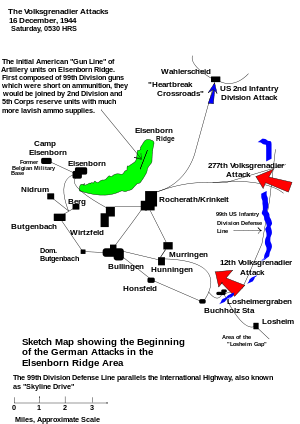
Large numbers of German infantry from the 12th Volksgrenadier Division followed the barrage and attacked, beginning the ground offensive west towards their eventual goal of Antwerp. The 99th Division and its three regiments, the 393rd, 394th, and the 395th, were on the northern shoulder of the German offensive and in the towns and villages to the east and south of the Elsenborn Ridge. Intelligence that reached them was spotty and contradictory. General Lauer, commanding officer of the 99th, ordered Col. Robertson to stay put until at least the next morning when more orders would be forthcoming. Robertson told his men to hold and he also prepared them for an orderly withdrawal in the morning.
The main drive against Elsenborn Ridge was launched in the forests east of the twin villages on the early morning of 17 December. This attack was begun by tank and Panzergrenadier units of the 12th SS Panzer Division Hitlerjugend. By 11:00, this attack had driven units of the U.S. 99th Infantry Division back into the area of the twin villages. These units were joined by forces of the U.S. 2nd Infantry Division moving into the villages from the north. Tanks from the U.S. 741st Tank Battalion supported the withdrawal but were quickly destroyed by German Panther tanks advancing with the Panzergrenadiers. The U.S. withdrawal was hastened by an increasing shortage of ammunition. Fortunately for the defense, three tank destroyers of the U.S. 644th Tank Destroyer Battalion arrived with a good supply of bazookas and anti-tank mines. These reinforcements were put to good use when the 12th SS Panzer Division launched a powerful tank and infantry attack on the twin villages.[17] The U.S. forces responded with a powerful artillery barrage supported by mortar fire, bazooka rockets, and anti-tank mines that repelled the German attack by midnight.[18] The German attack failed to clear a line of advance for the 12th SS.
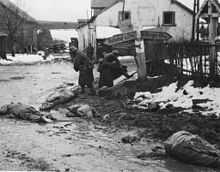
Immediately southeast of Elsenborn, the 1st SS Panzer Division, spearhead of the entire German 6th Panzer Army, a critical element in the German offensive, was held up for all of December 16 along its Rollbahn to the west by a single Intelligence and Reconnaissance platoon of the 394th Infantry Regiment. Dug in on a slight ridge overlooking a village of about 15 homes, in the vicinity of the Losheim Gap, the 18 man platoon, led by a 20-year old lieutenant Lyle Bouck Jr., inflicted 93 casualties on the Germans during a 20-hour-long fight at a key intersection southeast of Krinkelt-Rocherath. They seriously disrupted the entire German German Sixth Panzer Army schedule of attack along the northern edge of the offensive.[19] The entire platoon was recognized with a Presidential Unit Citation, and every member of the platoon was decorated, making it the most highly decorated platoon of World War II.[19] During the night of the 16th and dawn of the 17th, General Walter Melville Robertson, Commander of the U.S. 2nd Infantry Division, consolidated his and other forces moving through the area around the twin villages. He moved his headquarters from Wirtzfeld, south and west of the twin villages, to Elsenborn, just west of the ridge line. Robertson also informed General Leonard T. Gerow, commander of V Corps, that he intended to hold the twin villages until troops east of the villages had retreated through them to the ridge line, which then would become the next line of defense. This defensive line was intended to safeguard the key high ground on Elsenborn Ridge from the German advance.
On the German side, demands from Walter Model and Gerd von Rundstedt that Elsenborn ridge be captured and the advance of Sixth Panzer Army resume had been pouring down the chain of command into 12th SS Panzer Headquarters.[20] General Hermann Priess, commander of the 1st SS Panzer Corps, ordered Waffen-SS Obersturmbannführer Hugo Kraas, Commander of the 12th SS Panzer division, to take command of all forces facing Elsenborn ridge, and capture it.[21]
Fighting for Höfen
The 3rd Battalion, 395th was positioned near the joint towns of Höfen and Monschau. From 0525 to 0530, the battalion's positions "in and around Höfen received a heavy barrage of artillery and rockets covering our entire front line."[8]:173 The enemy fire cut all land-line communication channels between the front-line units and headquarters. Only some radio communications between front line and the heavy weapons company remained intact.
Twenty minutes after the barrage was lifted, at 0555, German infantry from the 753rd Volksgrenadier Regiment, Heeresgruppe B, attacked the 395th in the dark in strength along five different points. The Volksgrenadier were new units formed within the German army in the fall of 1944. They were formed by conscripting boys and elderly men, men previously rejected as physically unfit for service, wounded soldiers returning from hospitals, and transfers from the "jobless" personnel of the quickly shrinking Kriegsmarine and Luftwaffe, usually organized around small cadres of hardened veterans.
The German attack concentrated in the battalion's center, between I and K Companies. Another German force attempted to penetrate the Monschau area, immediately north of the Battalion's extreme left flank. Without radio communications between the front-line artillery liaison officer and 196th Field Artillery, their guns could not be brought to bear on the German assault until communication was restored in the midst of the battle at 0650. The 395th initially pushed the Germans back with machine guns, small arms, mortar fire, and hand-to-hand combat. Without any significant armor support, the 395th stopped the German advance cold. U.S. artillery had registered the forward positions of the U.S. infantry and rained fire on the exposed advancing Germans while the U.S. soldiers remained in their covered foxholes. It was the only sector of the American front line on the Battle of the Bulge where the Germans failed to advance.[2]
By 07:45, the Germans withdrew, except for a group of the 753rd Volksgrenadier Regiment who penetrated the Battalion's center. They were soon repulsed. Just after noon, at 1235, the Germans launched their attack again, and they were pushed back by artillery and mortar fire. The result of the first day of what would become known as the Battle of the Bulge were 104 Germans dead "in an area 50 yards (46 m) yards in front of our lines to 100 yards (91 m) behind the line, and another 160 wounded counted in front of battalion lines."[8]:173 The 3rd Battalion lost four killed, seven wounded, and four missing. "We learned from a German Lieutenant prisoner of war that the enemy's mission was to take Höfen at all costs."[8]:173 The northern shoulder of the counterattack was the key to three of the German Sixth Panzer Army, commanded by Oberstgruppenführer der Waffen-SS Josef ("Sepp") Dietrich. His Army had been allocated the bulk of the German Army's armored strength for the attack. The German plan was to conserve armor by penetrating the American lines with infantry, followed up by the armored regiments. Dietrich had planned five Rollbahnen, battle routes, through the sector to Antwerp.
By the afternoon of December 17, the 395th Regiment realized that the day's action was part of a much larger offensive.[22] At one point in the middle of the next night, a German company commander marched his company of about 200 men up to a house that he thought was unoccupied, and next to a ditch in which an infantryman with a BAR was dug in.
| “ | Once the German officer got there, he called for a meeting of his noncoms—at a spot right in front of this BAR man's foxhole. That was a long night. The BAR man stood it just as long as he could and then he cut loose. The Germans pulled back to organize, and he pulled back to another foxhole. They attacked and he cut them down again. Then he moved back to his original foxhole and the Germans attacked where he’d been. He cut them down again. Then the rest of the men in the eight-man squad got into the act. Come daylight, there was one lieutenant and about eight Germans left.[23] | ” |
During the third day of the offensive, a group of about 100 Germans opened a wedge in the American lines about 100 yards (91 m) by 400 yards (370 m) and seized four stone buildings in the village of Höfen. The American's direct rifle and mortar fire failed to dislodge them from the buildings they occupied. The 612th Tank Destroyer Battalion brought their 57mm anti-tank guns to bear directly on them. Follow up attacks with white phosphorus grenades finally caused the remaining 25 Germans to surrender, while 75 were found dead within the buildings. The German attack on the U.S. extreme left flank was repulsed by artillery and rifle fire. Despite the fierce onslaught, the battalion was able to hold onto its reserves, which in any case only consisted of one platoon of forty men from L Company.[8]:173
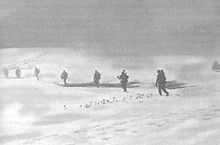
At 17:30 on December 19, the 393rd and 394th Infantry Regiments of the 99th withdrew from their positions around the Baracken Crossroads, near the twin towns of Krinkelt and Rocherath to the south, retreating along a boggy trail about 4 kilometres (2.5 mi) toward Elsenborn Ridge. American lines collapsed on either side of the Regiment. "We were sticking out like a finger there", Butler said.[23] Increasingly isolated, the unit was running low on ammunition. A resourceful platoon leader found an abandoned German ammo dump. "We stopped the tail end of that push with guns and ammunition taken off the German dead", Butler said.[23]
Fighting over twin villages
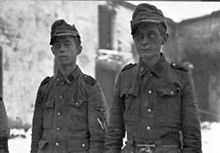
On December 18, German infantry and armour attacked the twin villages again. They were supported by the German 560th Heavy Antitank Battalion equipped with the state-of-the-art Jagdpanther tank destroyer.[24] The Jagdpanther was armed with the 88mm cannon and the German leadership expected it to be the decisive element of the battle. The battle opened on the morning of the 18th with both sides ordering in artillery, and German armored vehicles advanced into the twin villages. All that day and night, the battle raged, with SS tank and assault guns hitting the villages from the east, supported by a barrage of Nebelwerfer rockets. These forces were met in turn by a hailstorm of U.S. heavy artillery shells with proximity fuses and the Sherman tanks of the U.S. 741st Tank Battalion advancing from the north. The narrow streets of the town made effective maneuver difficult. Bazooka rounds fired from rooftops and artillery air bursts caused by proximity fuses created a lethal rain of splinters. Unable to plow swiftly through the rubble to the open country of the ridge line, the SS Panzer armor was stopped by artillery, anti-tank rockets, and mines. In this maelstrom of death neither side was inclined to take prisoners, and the losses on both sides were catastrophic.[25]
Withdrawal to Elsenborn Ridge
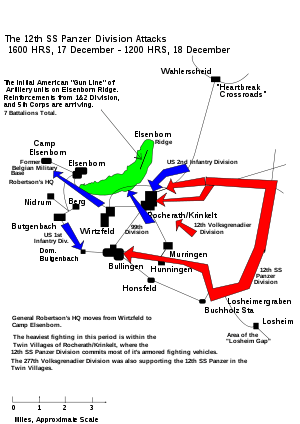
| Wikisource has original text related to this article: |
While this action raged, troops from the U.S. 1st Infantry Division and 9th Infantry Divisions moved into position to fortify Elsenborn Ridge. During the day on 19 December all forces abandoned the rubble of the twin villages, and General Robertson ordered the American forces to withdraw to defensive positions along the ridge line. Troops from the 99th Infantry Division also used this time to withdraw to Elsenborn ridge and fortify positions on it. They found it required dynamite to blow holes in the frozen ground.[26]:258 On the German side it was decided to shift the main axis of the attack to the south. On the dawn of the 19th, a new armored attack by the 12th SS Panzer Division, and supported by infantry of the 12th Volksgrenadier Division, was launched on the town of Domäne Butgenbach, to expose the right, or south end, of the Elsenborn Ridge defense line.[27]
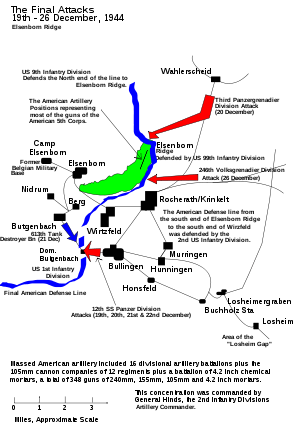
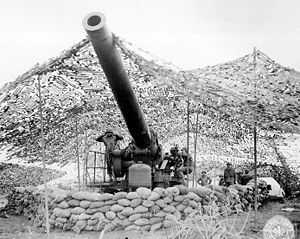
This attack also was met by a deluge of American artillery and anti-tank gun fire from units of the American 1st Infantry Division, as was a second attack on the 20th. This attack was supported by an attack by the 3rd Panzergrenadier Division, hitting the left or north side of Elsenborn ridge. This attack was made against 99th Infantry Division troops with the attack coming from the Schwalm Creek valley.[28] All these attacks were repelled with heavy losses. On December 21, an even heavier attack by the 12th SS Division was made, but the U.S. 613th Tank destroyer Battalion equipped with the M36 tank destroyer stopped that attack also. December 22 saw the last attack on the right of Elsenborn ridge; this was also smothered by heavy American artillery fire, which fired 10,000 rounds in one day. The U.S. Army Air Forces made a spectacular return to the skies of the ridge on December 23, along with the support of a heavy artillery battery of M1 howitzers. The defenders cheered wildly at the return of clearer weather and much heavier support.[26]:323 On December 26, the 246th Volksgrenadier Division made a final, forlorn, attack on the Elsenborn ridge against units of the U.S. 99th Infantry Division. This attack by more infantry conscripts was mowed down by artillery fire virtually at the moment of its start. The vast artillery concentration of an entire American army corps made the Elsenborn Ridge position virtually unassailable.[29]
Disproportionate German casualties
The casualties inflicted by the 395th Infantry Regiment, 99th Division, on the Germans are reflected by the disproportionate numbers of dead and wounded. The 395th hit the Germans with such terrific small arms and machine gun fire that they couldn't even remove their dead and wounded in their rapid retreat.[30] The accurate fire from the twelve 3-inch guns of A Company, 612th Tank Destroyer Battalion, was instrumental in keeping German tanks from advancing. During the first day of the Battle of the Bulge, the 3rd Battalion took 19 prisoners and killed an estimated 200 Germans. Accurate estimates of German wounded were not possible, but about 20 percent of the 326th Volksgrenadier Division were lost. The 395th's casualties were extremely light: four dead, seven wounded, and four men missing.[31]:vii :51
On another day, the 3rd Battalion took 50 Germans prisoner and killed or wounded more than 800 Germans, losing only five dead and seven wounded themselves.[23] On more than one occasion, BAR gunners allowed German troops to walk within feet of their positions before opening fire, with the objective of increasing the odds of killing the attacking Germans. "In two cases, the enemy fell in the BAR gunners' foxholes."[8]:173 On at least six occasions they called in artillery strikes on or directly in front of their own positions.[32]
As the battle ensued, small units, company and less in size, often acting independently, conducted fierce local counterattacks and mounted stubborn defenses, frustrating the German's plans for a rapid advance, and badly upsetting their timetable. By December 17, German military planners knew that their objectives along the Elsenborn Ridge would not be taken as soon as planned.[15]
The 99th as a whole, outnumbered five to one, inflicted casualties that devastated the attacking Volksgrenadier formations. The 99th lost about 20% of its effective strength, including 465 killed and 2,524 evacuated due to wounds, injuries, fatigue, or trench foot. German losses were much higher. In the northern sector opposite the 99th, this included deaths on a scale that routed the attacking infantry, and included the destruction of many tanks and assault guns. This performance prevented the Sixth Panzer Army from outflanking Elsenborn Ridge, and resulted in many commendations and unit citations for the 99th.[7]
Aftermath
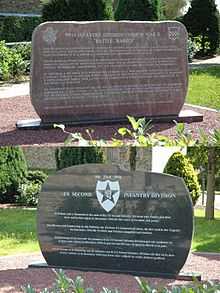
At sunrise on December 27, 1944, Sepp Dietrich and his 6th Panzer Army were in a difficult situation.[33] The high ground of Elsenborn Ridge and two of the three roads to Antwerp remained solidly in American fortified defense zones.[5][34] The 12th SS Panzer Division, 3rd Panzergrenadier Division, and its supporting Volksgrenadier divisions had beaten themselves into a state of uselessness against the heavily fortified Elsenborn Ridge position.[5] It was the only sector of the American front line on the Battle of the Bulge where the Germans failed to advance.[2] Historian John S.D. Eisenhower noted, "...the action of the 2nd and 99th divisions on the northern shoulder could be considered the most decisive of the Ardennes campaign."[34]:224
The organized retreat of the U.S. 2nd and 99th Divisions to the Elsenborn Ridge line and their subsequent stubborn defensive action blocked the 6th Panzer Army's access to key roads in northern Belgium that they were counting on to reach Antwerp. Kampfgruppe Peiper was forced to choose the more difficult rollbahn D to the south in its drive west to the Meuse River.[35]
Kampfgruppe Peiper and the 1st SS Panzer Division chose an alternative route west, bypassing Elsenborn Ridge to the north, but later bogged down on the only available road, plagued by overcrowding, flanking attacks, blown bridges, and lack of fuel.[34]:463 The rapid advances seen in 1940, where General Heinz Guderian’s panzers swept from the Ardennes to the English Channel, were not to be repeated.[36]:115
The cost of this relentless, close-quarters, intense combat was high for both sides, but the losses for Germany were irreplaceable. An exact casualty accounting for the Elsenborn Ridge battle itself is not precise. The U.S. Army's 2nd and 99th Infantry divisions later revealed their losses, while only the German's armored fighting vehicles losses are accounted for.[5]
To the south of the 12th SS Panzer Division, the 5th Panzer Army led by Hasso von Manteuffel advanced over more accessible terrain and enjoyed much greater initial success.[37] Despite more rapid advances, and inflicting more losses on the Americans, the 5th Panzer Army also bogged down before crossing the Meuse.[38]:340 Isolated, but strong pockets of resistance, traffic jams, supply problems, and American air power eventually stopped this arm of the offensive also.[34]:463
Weapons and tactics
German combined arms
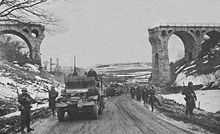
The force and mobility of the attack depended on the commitment of Germany’s latest weapons and armored fighting vehicles. At the beginning of World War II, the German army had led the world in mechanized warfare tactics, overwhelming enemies repeatedly with their rapid blitzkrieg attack. Late in the war, the Germans had developed a number of advanced armored vehicles and they planned to use them to beat the Americans, despite not having won a major offensive battle against them since the Kasserine Pass in early 1943. These vehicles were armed with the most powerful weapons used in the course of the war. The Tiger II, Panther tank and Jagdpanther were armed with newer high velocity cannon, the 8.8 cm KwK 43 L/71 cannon, and the 7.5 cm KwK 42. Due to their flat trajectory and greater armor penetration and the fact that thicker armor was used to shield them, German tanks enjoyed a definite superiority to any American vehicle in use. These units were supported by new Volks-Werfer Brigades, artillery units firing masses of 150 mm and 300 mm rockets. Although lacking in accuracy, a barrage from these units could cover greater areas with more high explosive. For more infantry firepower, SS panzergrenadiers were equipped with the new Sturmgewehr 44 (assault rifle model 1944). This was the world’s first assault rifle and more advanced than any other military rifle in the world. Another addition to the firepower of the German infantry was the Panzerfaust 100, an improved short range anti-tank rocket grenade that could penetrate any armor fielded by the American army.[39]:154–61 Despite their superiority, the advanced German armor were fewer in number and often experienced breakdowns.
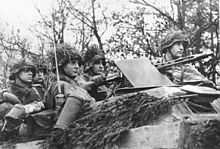
German tactics for the offensive involved an initial intense artillery barrage, followed by an immediate infantry attack by the Volksgrenadier divisions supported with light assault guns like the Sturmgeschütz IV. This initial attack with relatively non-mobile and relatively expendable troops was intended to clear major roads for use by the SS Panzer divisions, which would then rapidly move to capture bridges on the Meuse river for the final drive to Antwerp. These armored divisions were employed in a much more organized and controlled fashion, and with better leadership, than was the standard in U.S. armies. The German concept of the armored division involved independent units that carried with them all their supporting elements, making them more mobile, flexible, and able to concentrate greater force at the point of attack. Shock and high speed would overwhelm resistance, as did the first drive from the Ardennes in 1940. These tactics made up what was referred to in the press as the blitzkrieg, or lightning war. This evolution of mechanized attack was more sophisticated than tactics used by the American army. It was expected that the allied high commands would take weeks to adjust to the impact.[38]:334, 340 Hitler however failed to consider the constricted, winding, often unpaved roads of the northern Ardennes.[40] The Sixth Panzer Army's assigned Rollbahn included narrow, in many places single-track, roads which would force units of the Kampfgruppe to tail each other for several miles, preventing them from concentrating their force which was their most effective use.[41] Due to the secrecy applied to the offensive, Peiper was unable in advance of the attack to reconnoiter the roads which he dismissed as barely more than bicycle tracks.
American innovations and tactics
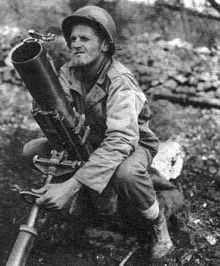
On the American side, the defense depended on field fortifications, and innovative use of light anti-tank weapons like the bazooka and anti-tank mines and the support of a formidable array of indirect fire. American tanks and anti-tank guns were considered ineffective against the newer German fighting vehicles. This was compensated to some extent by use of the 76 mm (76.2 mm) M1A1 gun, designated as the 3-inch cannon, mounted on the Sherman tank and the M18 Hellcat tank destroyer. The British had also designed high velocity anti-armor ammunition for the 57mm anti-tank cannon, which gave this gun a new lease on life against the new heavier German units. American gunners were quick to trade for whatever their allies wanted for this highly effective ammunition.[42] The Americans also adapted the 90mm anti-aircraft gun as an anti-tank cannon, the 90mm cannon, and mounted it on an open turret on the Sherman tank as the M36 Jackson tank-destroyer. This was another innovation effective against German heavy tanks.[43]:167
Since the invasion of Europe, the American army had suffered greater than expected losses, and found slashing German armored counter-attacks particularly difficult.[39]:11 Learning from this, overall American tactics began to include a defense in depth, using mobile armored cavalry squadrons with light tanks and anti-tank guns to screen defensive positions behind them. When attacked, these cavalry units would delay the Germans for a short time, then retreat through stronger positions to their rear. These positions consisted of fortifications set around terrain choke points like villages, passes, and bridges. In the area of Elsenborn Ridge, the twin villages and the area of Domäne Bütgenbach proved to be the best areas for defense. Machine gun and infantry positions would be protected by barbed wire and mine fields. Anti-tank mine "daisy chains" were also prepared. These were composed of a line of mines lashed in a row. This chain of mines would be dragged across a road with a rope when a column of German tanks threatened to advance down the road. This defensive line would be backed by bazooka positions in buildings, dug-in anti-tank guns, and tank destroyers firing from covered positions further in the rear.[39]:20–1
As German mobile units stacked up against these defenses, the Americans would call into play their superior communications and artillery tactics like “time on target”, a sequence of firing so that all shells impacted on the target simultaneously, to rain specially fused shells upon them with indirect fire. This allowed vast arrays of artillery pieces, distant from the battle to concentrate unprecedented firepower on concentrations of German attacking units. This defense would also involve abundant tactical air support, usually by P-47 Thunderbolt fighter bombers. These “flying tanks” were armed with air to surface rockets which were very effective against the thinly armored upper decks of German armored vehicles. The snowstorms of December forestalled this dimension of the defense. The U.S. Army was also lavishly supplied with the self-propelled artillery, aircraft, and the ammunition it took to make these firepower based tactics successful. If effectively employed and coordinated, these attacks negated the advantage of superior German armor and armored tactics, although at a cost paid by the U.S. infantry, for saturation indirect fire tended to destroy both friend and foe alike.[44]
Strategy and leadership
The plan and timing for the Ardennes attack sprang purely from the mind of Adolf Hitler. He believed a critical fault line existed between the British and American military commands, and that a heavy blow on the Western Front would shatter this alliance. Planning for the “Watch on the Rhine” offensive emphasized secrecy and the commitment of overwhelming force. Due to the use of landline communications within Germany, motorized runners carrying orders, and draconian threats from Hitler, the timing and mass of the attack was not detected by ULTRA codebreakers and achieved complete surprise. The allied leadership never saw it coming.[45]
Hitler had always resented the blue-blood Prussian leadership of the German army. So, when selecting leadership for the attack, he felt that the implementation of this decisive blow should be entrusted to his own private army, the Waffen SS. Ever since German regular Army officers attempted to assassinate him, he had increasingly trusted only the Waffen SS.[46] After the invasion of Normandy, the SS armored units had suffered significant leadership casualties. These losses included SS Major General Kurt Meyer, commander of the 12th SS Panzer Division, captured by Belgian partisans on September 6, 1944.[47]:10 [48]:308 The tactical efficiency of these units were somewhat reduced. The strong right flank of the assault was therefore composed mostly of SS Divisions under the command of Sepp Dietrich, a political ally of Hitler, and a loyal follower from the early days of the rise of National Socialism in Germany. The leadership composition of the Sixth Panzer Division had a distinctly political theme. It was also more lavishly equipped than 5th Panzer Army to the south, and given the shortest route to the ultimate objective of the offensive, Antwerp.[49]
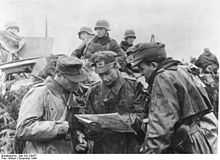
None of the German field commanders entrusted with planning and executing the offensive believed it was possible to capture Antwerp. Even Sepp Dietrich, commanding the strongest arm of the attack, felt that the Ardennes was a poor area for armored warfare, and that the inexperienced Volksgrenadier units would clog the roads that the tanks would need for their rapid advance. In this Dietrich was proved correct. The horse drawn artillery and rocket units were a significant obstacle to the tanks.[26]:113 Other than making futile objections to Hitler in private, he generally stayed out of the planning for the offensive. Model and Manteuffel, the technical experts from the eastern front, took the view that a limited offensive with the goal of surrounding and crushing the American 1st Army would be the best the offensive could hope for. These revisions shared the same fate as Dietrich’s objections. In the end, the headlong drive on Elsenborn Ridge would not benefit from support from German units that had already bypassed the ridge. The decision to stop the attacks on the twin villages and change the axis of the attacks southward to the hamlet of Domäne Bütgenbach, was also made by Dietrich.[34]:224 This decision played into American hands, as Robertson had already decided to abandon the villages. However, the staff planning and organization of the attack was well done; most of the units committed to the offensive reached their jump off points undetected and were well organized and supplied for the attack.
On the American side, most of the upper levels of leadership above division level took themselves out of the battle due to poor handling of intelligence, and the decision not to provide a mobile reserve force for meeting unforeseen contingencies.[34]:162 One of the fault lines between the British and American high commands was General Dwight D. Eisenhower’s commitment to a broad front advance with no strategic reserve. This view was opposed by the British Chief of the Imperial General Staff, Field Marshal Alan Brooke, who promoted a rapid advance on a narrow front, with the other allied armies in reserve.[34]:91 This basic disagreement was the wedge Hitler hoped to exploit with his counteroffensive, and the fact that a breakthrough was achieved seemed to justify the British objections. Also the British remembered a similar German armored counterattack at Kasserine Pass in North Africa, where the American army was routed by the German strike, once again confirming the British conservative view of strategy.[50]:339 The abrasive British Field Marshal Bernard Montgomery was quick to widen this gap with characteristically inflammatory correspondence and public pronouncements, and a major break with the U.S. command seemed in the offing. Major General Freddie de Guingand, a staff member of Montgomery’s 21st Army Group, brilliantly rose to the occasion, and personally smoothed over the crisis on December 30.[51]:489–90
Fortunately for the defense of Elsenborn ridge, Gerow, the commander of the American 5th Corps recognized the magnitude of the attack. He ordered the U.S. 2nd Infantry Division to stop its attack toward Wahlerscheid and pull back to the high ground of Elsenborn Ridge.[34]:221 Robertson, Commander of the 2nd Division, was skillful enough to make this difficult maneuver, and consolidate a defense line that held the line before the ridge. Another important contribution was that of Colonel Oscar A. Axelson, who released the proximity fuse for immediate use by the artillery, despite its secret status. This technical edge made U.S. artillery much more effective than it would have been. From the standpoint of leadership though, the fact that General Robertson was willing to undertake the responsibility of holding the line, and stand that line himself seemed to tip the balance of victory on Elsenborn Ridge.
References
- ↑ Cole 1964, pp. 259-271.
- ↑ 2.0 2.1 2.2 Zaloga 2003, p. 33.
- ↑ MacDonald 1985, pp. 410-411.
- ↑ Nyssen, Léon (July 15, 2007). "The Battle of Elsenborn December 1944 (Part V)". Centre de Recherches et d'Informations sur la Bataille des Ardennes. Retrieved June 6, 2011.
- ↑ 5.0 5.1 5.2 5.3 MacDonald 1985, pp. 410.
- ↑ Ralph E. Hersko, Jr. (November 1998). "Battle of the Bulge: U.S. Troops Fight at Elsenburn Ridge". HistoryNet.com. Retrieved 2010-07-14.
- ↑ 7.0 7.1 Dean, Rob. "Why the Bulge Didn't Break: Green Troops Grew Up Fast to Become Heroes of Hofen". American Forces in World War II. Military History Online. Retrieved 17 March 2009.
- ↑ 8.0 8.1 8.2 8.3 8.4 8.5 Neill, George W. (2001). Infantry Soldier: Holding the Line at the Battle of the Bulge. University of Oklahoma Press. ISBN 0-8061-3380-5. Morning report to the 395th Regiment, December 15, 1944
- ↑ Canella, Charles J., Major (1948-49). Defense of Small Towns and Villages by Infantry... Defense of Hofen, Germany, by the 3rd Battalion, 395th Infantry, 99th Division, 10 November-18 December 1944... (PDF). Staff Department, The Infantry School, Fort Benning, Georgia. Check date values in:
|date=(help) - ↑ Fabianich, Maj. Keith P. (1947). "The Operations of the 3rd Battalion, 395th Infantry (99th Infantry Division) Prior to and During the German Counter-Offensive, 10 November - 24 December 1944 (Ardennes Campaign) (Personal Experience of a Company Commander and Battalion Operations Officer)" (PDF). Advanced Infantry Officers Course, 1947-1948. General Subjects Section, Academic Department, the Infantry School, Fort Benning, Georgia. Retrieved 2009-02-24.
- ↑ MacDonald 1985, p. 97.
- ↑ von Luttchau, Charles V. P. "The German Counteroffensive in the Ardennes". U.S. Army Center for Military History.
- ↑ MacDonald 1985, pp. 19-20.
- ↑ McDonald, Terrence T. (February 19, 2009). "Surviving the Battle of the Bulge". The Montclair Times. Retrieved 2009-03-09.
- ↑ 15.0 15.1 Cole 1964, pp. 75-106.
- ↑ MacDonald 1985, pp. 161-162.
- ↑ MacDonald 1985, pp. 166-167.
- ↑ MacDonald 1985, pp. 376-390.
- ↑ 19.0 19.1 Della-Giustina, Captain John (January–March 1996). "The Heroic Stand of an Intelligence Platoon:". Military Intelligence Professional Bulletin. Retrieved 2009-03-17.
- ↑ MacDonald 1985, pp. 394–395.
- ↑ MacDonald 1985, pp. 181-182.
- ↑ Gillot Jr, Gunter G. "612th Tank Destroyer Battalion". Retrieved 2009-03-17.
- ↑ 23.0 23.1 23.2 23.3 Cappellini, Matthew (June 1996). "Butler's Battlin' Blue Bastards". Military History. Retrieved 2009-03-07.
- ↑ MacDonald 1985, pp. 395,649.
- ↑ MacDonald 1985, pp. 396–401.
- ↑ 26.0 26.1 26.2 Astor, Gerald (1992). A Blood Dimmed Tide, The Battle of the Bulge by the Men Who Fought It. Donald I. Fine, Inc. ISBN 1-55611-281-5.
- ↑ MacDonald 1985, pp. 401-404.
- ↑ MacDonald 1985, p. 409.
- ↑ MacDonald 1985, pp. 404-411.
- ↑ McMullen, Tom (2001). "Bob Galloway, the Battle of the Bulge, and the 99th Infantry Division". Retrieved 2009-03-07.
- ↑ Ronningen, Thor (1993). Buttler's Battlin' Blue Bastards. Lawrenceville, Virginia: Brunswick Publishing Company. p. 219. ISBN 1-55618-132-9.
- ↑ ""Battle Babies:" The Story of the 99th Infantry Division". U.S. Army Orientation Branch, Information and Education Division, ETOUSA. Retrieved 2009-03-07.
- ↑ MacDonald 1985, p. 411.
- ↑ 34.0 34.1 34.2 34.3 34.4 34.5 34.6 34.7 Eisenhower, John S.D. (1969). The Bitter Woods (First ed.). G.P. Putnam's Sons, New York. ISBN 0-306-80652-5.
- ↑ MacDonald 1985, p. 371.
- ↑ Guderian, Heinz (1996). Panzer Leader (First ed.). Da Capo Press. ISBN 0-306-80689-4.
- ↑ MacDonald 1985, p. 102.
- ↑ 38.0 38.1 Von Mellenthin, F.W. (1956). Panzer Battles, A Study of the Employment of Armor in the Second World War. The University of Oklahoma Press. ISBN 1-56852-578-8.
- ↑ 39.0 39.1 39.2 Cooper, Belton Y. (2001). Death Traps: The Survival of an American Armored Division in World War II. Presidio Press, Inc. ISBN 0-89141-722-2.
- ↑ Kershaw, Alex (October 30, 2005). The Longest Winter: The Battle of the Bulge And the Epic Story of World War II's Most Decorated Platoon. Da Capo Press. p. 330. ISBN 0-306-81440-4.
- ↑ Quarrie, Bruce (1999). "The Ardennes Offensive: VI Panzer Armee". Osprey Order of Battle Series. Osprey Publishing.
- ↑ MacDonald 1985, p. 404.
- ↑ Crismon, Fred W. (1992). U.S. Military Tracked Vehicles. Motorbooks International Publishers & Wholesalers. ISBN 0-87938-672-X.
- ↑ MacDonald 1985, p. 396.
- ↑ MacDonald 1985, pp. 77–79.
- ↑ MacDonald 1985, pp. 21–22.
- ↑ Mitcham, Samuel W. (2006). Panzers in Winter, Hitler’s Army and the Battle of the Bulge. Praeger Security International. ISBN 0-275-97115-5.
- ↑ Meyer, Kurt (2005). Grenadiers, The Story of Waffen SS General Kurt "Panzer" Meyer. Stackpole Books. ISBN 978-0-8117-3197-3.
- ↑ Cole 1964, pp. 1-64.
- ↑ Atkinson, Rick (2003). An Army at Dawn, The War in North Africa, 1942-1943. Henry Holt and Company, LLC. ISBN 978-0-8050-8724-6.
- ↑ Larrabee, Eric (1987). Commander in Chief, Franklin Delano Roosevelt, His Lieutenants, and Their War. Simon & Schuster Inc. ISBN 0-671-66382-8.
Bibliography
- Cavanagh, William.C.C. (November 1, 2004). The Battle East of Elsenborn. Pen and Sword. p. 192. ISBN 1-84415-126-3.
- Cole, Hugh M. (1964), The Ardennes:Battle of the Bulge, Office of the Chief of Military History Department of the Army
- MacDonald, Charles B. (1985), A Time for Trumpets, The Untold Story of the Battle of the Bulge, William Morrow and Company, Inc., ISBN 0-688-03923-5
- Zaloga, Steven (January 15, 2003), Battle of the Bulge 1944 (1): St Vith and the Northern Shoulder (Campaign), Howard Gerrard (Illustrator), Osprey Publishing, ISBN 978-1-84176-560-0
External links
- European Center of Military History (Belgium)
- Battle of the Bulge : US Troops Fight along the Ridge in Elsenborn Belgium
- The German 560th Heavy Antitank Battalion
- Major General Walter Melville Robertson
- The 2nd Infantry Division Defends the Twin Villages
- The 644th Tank Destroyer Battalion
- Colonel Oscar A. Axelson and the Proximity Fuse